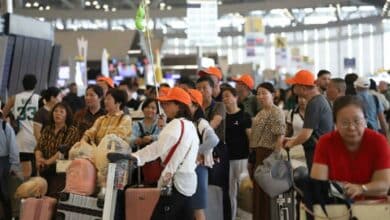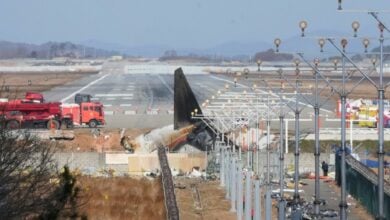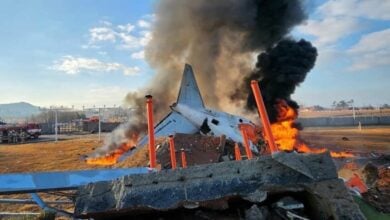World News
Explore the latest global news with The Thaiger’s World News page, your comprehensive source for international updates. We’ve got breaking news, insightful analysis, and exclusive stories from around the globe, covering politics, business, technology, and culture. Stay informed about the world’s most pressing issues, emerging trends, and influential events, as well as updates on travel, lifestyle, and entertainment.
The Thaiger is your go-to platform for staying connected with the ever-changing world we live in. To keep up with the most reliable international news source, subscribe to our newsletter and follow us on social media.
-
 Sponsored
Sponsored Siam Paragon celebrates 'A Prosperous Chinese New Year 2025'
Siam Paragon, in collaboration with KASIKORNBANK, is hosting a spectacular Lunar New Year celebration, Siam Paragon A Prosperous Chinese New Year 2025, from today until February 2, at Parc Paragon. This year’s event is inspired by the rich heritage of Dunhuang,...
-

Thailand’s aviation recovery nears pre-Covid levels: CAAT
Thailand’s aviation sector is anticipated to experience a robust recovery this year, reaching pre-pandemic levels, according to the Civil Aviation Authority of Thailand (CAAT). Suttipong Kongpool, the CAAT director, forecasts a rise in passenger numbers to at least 25 million, aligning with figures from 2019. Initially, full recovery expectations were set for last year; however, the slow return of Chinese…
-

Thai Airways’ A320 business class: Luxury or letdown?
Thai Airways is stepping up its game, rolling out regional business class on its single-aisle Airbus A320 jets, promising premium perks and a smoother flying experience. But is it the luxury upgrade travellers crave—or just a glorified economy seat with extra legroom? Dubbed Royal Silk Class, Thai’s A320 business cabin features 12 wide reclining seats with a 38” pitch and 5” recline—a significant improvement over…
-

Bangkok’s Suvarnabhumi leads Southeast Asia aviation industry
Southeast Asia’s aviation industry is taking off this year, with major airports and emerging destinations recording impressive growth in seat capacity. Fuelled by surging travel demand, expanded airline networks, and strategic connectivity upgrades, the region is cementing its position as a global aviation powerhouse. Leading the charge is Bangkok’s Suvarnabhumi Airport, adding a staggering 407,000 seats in January—a 16% increase…
-

China exposes 36 scam gangs targeting victims with 100k callers
Chinese police have revealed the shocking scale of international call scam operations, with 36 major gangs employing over 100,000 callers to swindle victims out of their money. The revelation came during a high-profile meeting between Chinese Assistant Minister of Public Security Liu Zhongyi and Thailand’s Cyber Crime Investigation Bureau (CCIB) in Nonthaburi yesterday. Leading a Chinese delegation, Liu sought Thailand’s…
-

Thai PM woos World Economic Forum founder to boost soft power
Prime Minister Paetongtarn Shinawatra met with World Economic Forum (WEF) founder Klaus Schwab in Davos yesterday, January 22, seeking to position Thailand as a hub for innovation and soft power on the global stage. The meeting took place during the 55th WEF, themed Collaboration for the Intelligent Age, running from January 20 to 24 in Switzerland. Highlighting the strong partnership…
-

Thai expat wins 96 million baht lottery in South Korea
A Thai national residing in South Korea has won a substantial lottery prize, amounting to nearly 100 million baht. The announcement, shared on the Facebook page แม่ อสม.เกาหลี Chanel – เพจใหม่ revealed that the prize totals 4,066,375,179 Koren won (approximately 96 million baht). The winner returned to Thailand yesterday, January 21. Following the post, many people left congratulatory comments, and…
-

Thai Airways: Ministry’s bid for more administrators rejected
The Central Bankruptcy Court has thrown out the Ministry of Finance’s bid to tighten its grip on Thai Airways’ rehabilitation, ruling that the current administrators are steering the airline’s recovery effectively. In a hearing yesterday, the court dismissed a proposal by the Ministry of Finance to appoint two additional administrators to oversee the struggling carrier’s rehabilitation. The bid aimed to…
-

Thai police deny plan to deport 48 Uyghur men to China
The Royal Thai Police (RTP) has refuted claims by human rights organisations that they are attempting to deport 48 Uyghur men to China. Since fleeing from China’s Xinjiang province in 2014, the group has reportedly been imprisoned, with 43 held at the Immigration Bureau headquarters and the remaining five in Thai prisons. Human Rights Watch has called on the Thai…
-

Thai durians cleared for export to China after contamination checks
Deputy Agriculture and Cooperatives Minister Itthi Sirilattayakorn recently inspected the export of durians free from Basic Yellow 2 and cadmium contamination at the Nakhon Phanom border checkpoint. Itthi discussed export strategies to China with the Department of Agriculture and relevant agencies. Following Agriculture Minister Narumon Pinyosinwat’s urgent policy on safe, high-quality fruit for domestic consumption and export, efforts to address…
-

VietJet Thailand to boost fleet and expand routes by 2025
VietJet Thailand has announced plans to expand its fleet for 2025 by leasing additional aircraft, pumping up numbers from the current 18 planes currently in operation. This information comes from Pinyos Phibulsongkhram, the Director of Commercial Affairs for VietJet Thailand. This expansion aims to support the airline’s route enhancement, particularly focusing on international destinations. Initially, five new routes are planned:…
-

Bangkok crowned second best city globally in 2025 rankings
If you’re dreaming of your next urban escape, look no further than Cape Town, crowned the world’s best city for 2025 by Time Out! From breathtaking nature to buzzing nightlife, this South African gem offers it all. “Where else can you visit a colony of African penguins, sip world-class wines, stroll pristine Blue Flag beaches, and enjoy views from one of the…
-

VietJet named one of world’s safest airlines in 2025
VietJet has been recognised as one of the world’s safest airlines for 2025 by AirlineRatings, a global safety and product rating website. The news was confirmed yesterday, January 16 that VietJet ranked alongside leading low-cost carriers such as Ryanair, easyJet, and Frontier Airlines, which have consistently been rated among the top airlines. This achievement highlights VietJet’s commitment to maintaining high…
-

US nominee Rubio vows to stop Uyghur deportations from Thailand
Donald Trump’s nominee for the position of US Secretary of State expressed intentions to persuade Thailand against deporting 48 Uyghurs to China, where they may face persecution. Marco Rubio, during his confirmation hearing in Washington, stated his commitment to this cause. The Republican senator from Florida is anticipated to be confirmed as the leading diplomat under the incoming Trump administration.…
-

Plane stupid! Australian man’s flight crash threat lands him in jail
A disgruntled Australian man found himself behind bars after making a chilling threat to kill everyone at 35,000 feet. His off-the-cuff remark about crashing a plane left airport officials with no choice but to take him seriously. Marli Curtis Philip Moncrieff embarked on what he thought would be a dream holiday from Perth to the sunny shores of Phuket with…
-

Hong Kong sends task force to rescue citizens trapped in Thailand
In response to reports of Hong Kong residents being lured to Southeast Asia and forced into illegal work, Hong Kong’s Chief Executive John Lee Ka-chiu announced that the Security Bureau has dispatched a task force to Thailand. The move comes as law enforcement agencies reveal that 28 residents have been trapped abroad since mid-2024, with only 16 successfully returned so…
-

Lufthansa and Thai Airways to revolutionise Eurasian travel
In a bold move to redefine travel between Europe and Asia, Lufthansa and Thai Airways International are supercharging their partnership with a codeshare expansion that’s set to shake up the aviation industry. Starting this month, travellers will have unprecedented connectivity to Southeast Asia, as flights from Bangkok to Hanoi, Ho Chi Minh City, and Manila take on a Lufthansa flight…
-

Thai Airways takes off at new Singapore terminal
In a major shake-up for travellers, Thai Airways is relocating its Singapore operations to Changi Airport’s Terminal 2 starting February 18. The move promises better lounge access and enhanced facilities for passengers flying the popular Bangkok-Singapore route. The switch marks the end of an era at Terminal 1, where Thai Airways operated for decades. The airline, which runs 35 weekly…
-

Noodle no more: Ramen shops fold under rising costs (video)
In an unprecedented wave of financial distress, a record number of ramen noodle eateries in Japan went belly up in 2024, unable to stomach the soaring ingredient and utility costs without raising their own prices. Research firm Teikoku Databank Ltd has revealed that insolvencies with liabilities of at least 10 million yen (approximately 2.2 million baht) surged by more than…
-

South Korea to upgrade airport structures after Jeju Air crash
South Korea is set to enhance the structures housing the antennas that facilitate landings at its airports, following the December incident where a Jeju Air aeroplane crashed after skidding off the runway. The Boeing 737-800 hit one such structure at Muan Airport, leading to a fire. The Transport Ministry has been assessing safety at airlines and airports since the crash…
-

Size matters? Truth about global penis size revealed
Let’s face it, curiosity about penis size is universal. But how much of what we think we know is true? Here’s the hard truth about size, myths, and what science says. Contrary to pop culture’s grand assumptions, studies reveal that penis size is surprisingly uniform worldwide. Research indicates the average erect length is between 12.9 centimetres (5.1 inches) and 13.92…
-

Thai airports get safety and check-in boost as travellers rise by 14%
The Transport Ministry has instructed the Department of Airports (DoA) to enhance measures in support of travellers following more than 14% rise in passenger numbers over the new year period. Deputy Minister Manaporn Charoensri announced yesterday, January 7, that from December 27 to January 2, the DoA recorded 319,275 passengers, reflecting a 14.12% increase compared to the previous year. The…
-

Thai AirAsia crowned Thailand’s punctuality king – again
Thai AirAsia has soared above the competition once more, retaining its title as Thailand’s most on-time airline and securing fifth place in Cirium’s prestigious list of top 10 on-time airlines in the Asia-Pacific region. With a punctuality rate of 77.46%, it’s the only Thai carrier to earn a spot in the rankings. CEO Santisuk Klongchaiya hailed the achievement as a…
-

High ambitions: Air India Express introduces new Phuket flights
Air India Express is making waves with its latest announcement: direct flights from Hyderabad to the tropical paradise of Phuket. Launching on January 31, these flights will initially operate thrice weekly—on Wednesdays, Fridays, and Sundays—before ramping up to six times a week from February 15, skipping only Tuesdays. This move comes hot on the heels of the airline’s new Bangkok route,…
-

Jeju Air flight disaster claims 28 lives in South Korea (video)
Jeju Air’s flight from Thailand tragically ended in disaster after skidding off the runway at Muan International Airport in South Korea. At least 28 people have lost their lives in the incident, as reported by prominent South Korean media. The plane, which departed from Bangkok, encountered difficulties during its landing and subsequently veered off the runway, colliding with a barrier.…
-

Thailand allows daily airport alcohol sales to boost tourism
The Prime Minister’s Office has implemented a regulation allowing the daily sale of alcoholic beverages at major international airports. This directive, detailed in the Royal Gazette on Christmas Day, became effective yesterday, December 26. The modification aims to align legal practices with the current situation, an observer noted. Prime Minister Paetongtarn Shinawatra, following the counsel of the Alcoholic Beverage Control…
-

Indian customs seize haul of weed smuggled from Bangkok
Five travellers arriving from Bangkok were busted in a brazen smuggling attempt at Mumbai’s Chhatrapati Shivaji Maharaj International Airport (CSMIA) on Christmas Day. Indian customs officials seized a staggering 26 kilogrammes of hydroponic marijuana—worth 26 Indian crores (approximately 104 million baht)—ingeniously concealed in everyday household items. Acting on a tip-off, the Indian Customs Department intercepted the suspects shortly after they…
-

Bird strike suspected in Azerbaijan Airlines crash, 42 dead
An Azerbaijan Airlines passenger plane tragically crashed near the city of Aktau in Kazakhstan, with initial investigations suggesting a bird strike as the possible cause. The incident occurred yesterday, December 25, leaving 42 people dead but miraculously 25 individuals survived the ordeal. The plane, which had departed from Baku, Azerbaijan, was en route to Grozny, Chechnya. Due to dense fog…
-

Teeing off diplomacy: Thailand celebrates 50 years with China
Thailand rolled out the green carpet in Pattaya for over 300 Chinese golf enthusiasts, blending sport and diplomacy in a high-profile event. The Amazing Thailand Golf Paradise 2024, held on December 19 at Siam Country Club Waterside and Rolling Hills, marked the 50th anniversary of Thai-China diplomatic relations with a swing and a celebration. Under Thailand’s specialised golf package tours,…
-

Malaysia Airlines grounds Airbus A330neo after technical issues
Malaysia Airlines has temporarily grounded its newly acquired Airbus A330neo aircraft due to technical problems, as reported by the Business Times. Following its debut flight to Melbourne, the aircraft experienced multiple technical issues, prompting the airline to take swift action. The national carrier of Malaysia received the Airbus A330neo at the end of November and has plans to acquire an…
Broke? Find employment in Southeast Asia with JobCute Thailand and SmartJob Indonesia. Rich? Invest in real estate across Asia with FazWaz Property Group or get out on a yacht anywhere with Boatcrowd. Even book medical procedures worldwide with MyMediTravel, all powered by DB Ventures.






























